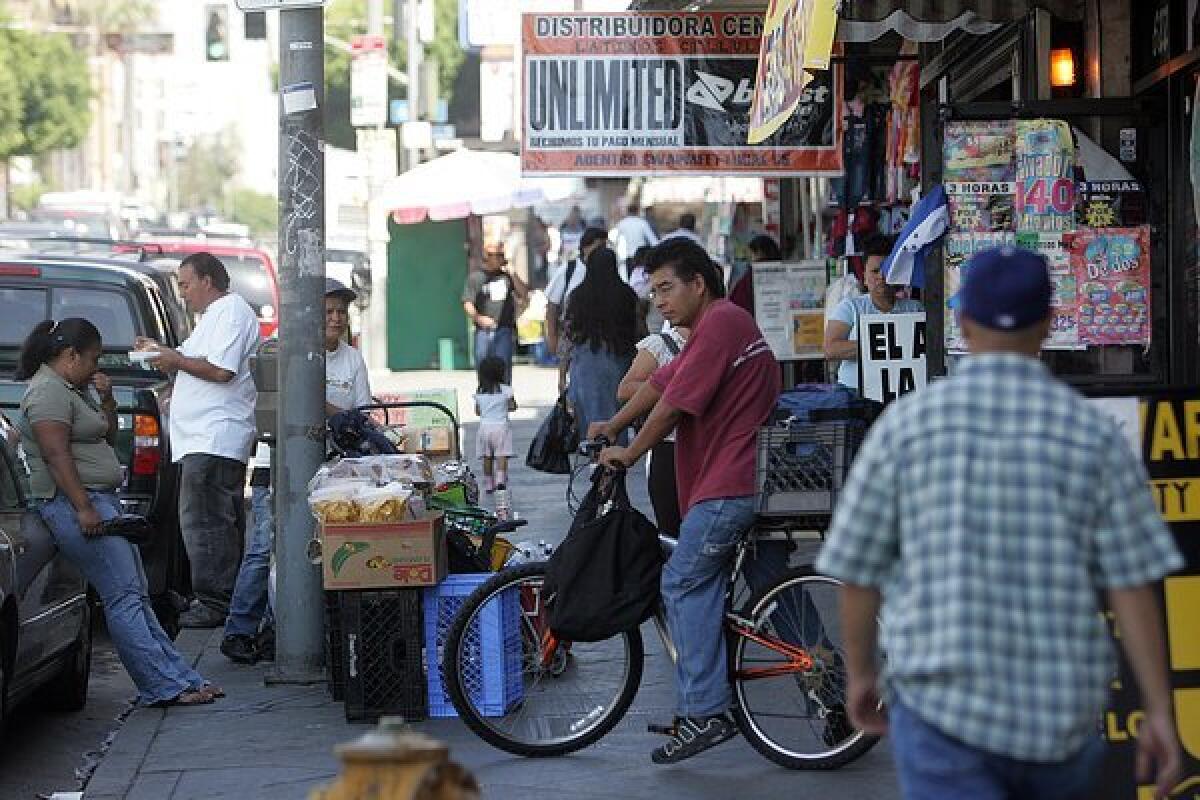How L.A.’s stratospheric housing costs help fuel the pandemic

- Share via
In 1991, poring over an analysis of newly released data from the previous year’s census, I came across a startling statistic: The most densely populated census tract in the United States wasn’t some Manhattan neighborhood of high-rise apartments. It was right here in Los Angeles, in the neighborhood centered on MacArthur Park, a mile or so west of downtown.
Could that be true?
I drove around the neighborhood and couldn’t find a single residential building taller than seven stories. On the other hand, the sidewalks were uncommonly crowded by L.A. standards, and it was clear that the area had become the end-of-century equivalent of New York’s Lower East Side in 1910, a neighborhood of hardworking immigrants struggling to make do. And given the city’s high rents and low pay for people on the bottom rungs of the economic ladder, it seemed likely that many of those apartments were home to several families or to platoons of single men.
Back then, I was an editor and columnist for the LA Weekly, seeking ways to explain our ever-changing city to readers. It was a time when TV producer Aaron Spelling’s then-new Holmby Hills mansion was sparking comment and controversy. The sprawling abode encompassed 56,000 square feet, providing 123 rooms for the Spelling family (two adults, two children) to somehow occupy. So, for my column, I decided to calculate how many people could inhabit the Spelling home if they lived as densely as those in the MacArthur Park tract.
The number was 164.
What I didn’t realize at the time was that the density figures and poverty levels of that west-of-downtown neighborhood portended, in concentrated form, the future of a broader swath of Los Angeles. The Soviet Union was about to dissolve, and the Cold War would soon draw to a close, decimating the industry that had employed more Angelenos than any other — aerospace and defense manufacturing.
Thousands upon thousands of decent-paying production and engineering jobs would soon vanish. But L.A. wasn’t Cleveland or Detroit; even as it deindustrialized, it also generated thousands upon thousands of low-paying service, retail and nonunion construction jobs. The new jobs were quickly filled by the vast numbers of immigrants fleeing here from war-wracked and impoverished nations in Central America and elsewhere.
In the 30 years since I first wrote about the MacArthur Park area, the most densely populated areas of the state remain those that are home to a largely Latino working class. In the 2010 census, the three most densely populated cities in the state were Maywood, Bell Gardens and Huntington Park, all in southeastern L.A. County.
In the last year, we have learned how that density poses a serious public health threat.
L.A.’s stratospheric housing costs have required many working-class residents here to double up or more when it comes to living arrangements. (According to a study last summer from the Refi Guide, 10 of the 20 U.S. cities with the least affordable housing are in L.A. County, including some on the county’s east side and, of course, Los Angeles itself.)
Consider what that means in the midst of a pandemic — in neighborhoods filled with low-wage workers in front-line jobs who share their residences with extended family members or even with other families. Consider why Los Angeles — and more specifically working-class Los Angeles — has among the highest rates of coronavirus infections in the nation.
The fundamentals of L.A. life — its large share of poorly paid, disproportionately essential workers crammed into an inadequate and unaffordable housing supply — make the area particularly susceptible to a pandemic spread by human proximity. How densely we live partly determines whether we sicken and die.
In time, of course, vaccinations will bring this pandemic to a halt. But those L.A. fundamentals will imperil the city the next time a pandemic comes around, even as they also diminish the city in everyday life.
Los Angeles needs vastly more affordable housing, and if it takes public subsidies or public housing to create it, that’s a cheap price to pay compared with the toll of recurring pandemics and the ongoing burden faced by residents who have to pay half their incomes simply to keep roofs over their heads.
As tax cuts from Reagan through Trump have helped spawn new generations of gazillionaires, mini versions of the Spelling mansion have become commonplace across the L.A. landscape. If taxes on the rich were restored to mid-20th century levels, future Spellings might have to settle for homes with just 53, rather than 123, rooms, but more funds would be available to adequately house working-class Angelenos.
It also would be nice if NIMBYists accepted, or were compelled to accept, some higher levels of density in their neighborhoods to create lower levels of density in other Angelenos’ homes. That would surely cut L.A.’s mortality rates the next time death so horrifically comes calling.
Harold Meyerson is editor at large of the American Prospect and a contributing writer to Opinion.
More to Read
A cure for the common opinion
Get thought-provoking perspectives with our weekly newsletter.
You may occasionally receive promotional content from the Los Angeles Times.









